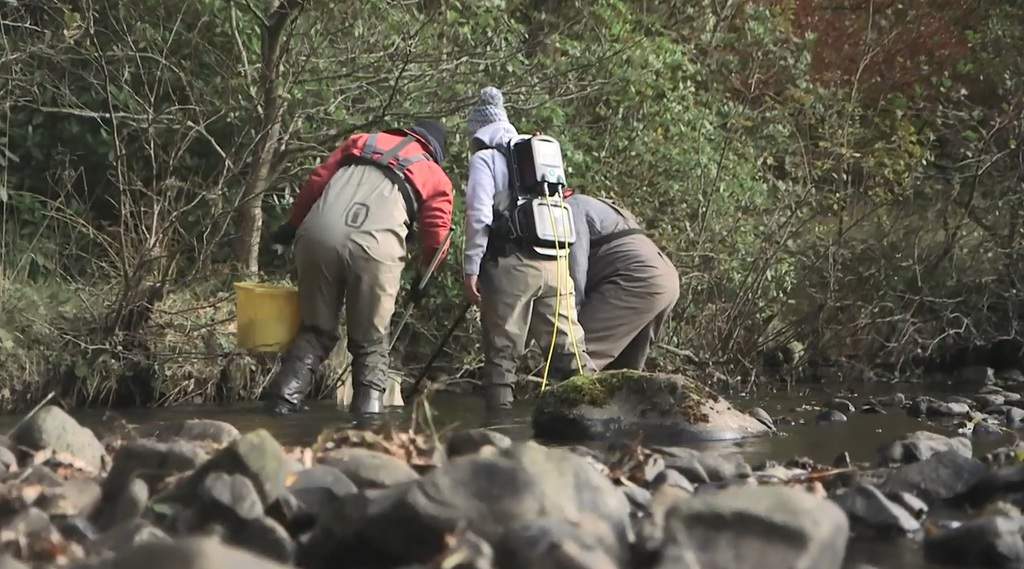A report published this week details the distribution of Salmon in the Upper Dee river in Kirkcudbrightshire, in South West Scotland. The report is based on electrofishing surveys undertaken by the Galloway Fisheries Trust through 2019 and outlines a series of proposed habitat works that would support the salmon population.
The main findings of the report are as follows:
- Wild juvenile salmon were present in five out of twenty electrofishing sites surveyed.
- Production of salmon was concentrated within the Polharrow Burn, where salmon were found as far upstream as an impassable fall within Waukers Linn.
- The first electrofishing record of salmon production within the Earlstoun Burn was made during the surveys undertaken within this project.
- Habitat improvement works should be considered, particularly addition of woody debris. The lower Earlstoun Burn is an area where active bankside erosion was recorded and could be addressed.
- The Water of Ken between Carsfad Dam and Craigs Linn has a lack of smaller substrates which appears to be limiting fish production. Possible option to increase smaller substrates here should be considered.
- Further electrofishing surveys should be undertaken within the upper reaches of the Polmaddy Burn to confirm salmon are not utilising the burn in favourable habitat.
- Water management practices should be discussed to see if there would be any potential to increase river flows between Polmaddy Burn outflow and Kendoon.
- A drone survey should be undertaken within the gorge section of river downstream of Polmaddie settlement to investigate for the presence of further impassable falls.
- Smolt (juvenile fish) sampling methods should be investigated surrounding the outflow of Polharrow Burn in order to input to a smolt tracking study planned for the river.
The work was undertaken as part of the Galloway Glens Scheme’s aim to better understand and support the fish populations in the Ken/Dee Catchment. The full report is available here: https://gallowayglens.org/wp-content/uploads/2020/11/Upper-Dee-Salmon-Restoration-Project-FINAL-Nov-20.pdf
Reviewing the completed report, Jamie Ribbens from Galloway Fisheries Trust, said:
“Salmon populations across Scotland are in desperate need of help due to falling stocks. GFT are working closely with key stakeholders on the Kirkcudbrightshire Dee, including land owners, Forestry organisations, SEPA, DRAX and the Dee District Salmon Fishery Board, to restore salmon stocks through a range of projects. To ensure these work, it is crucial to understand and identify where key sub-populations are located so that effective actions can take place in the right places. This report has shown the importance of the Polharrow Burn for supporting a juvenile salmon population but it has highlighted that they, and surrounding waters, need enhanced and protected. GFT appreciate the support we have received from Galloway Glens Landscape Partnership for this work. ”
The report formed part of the Galloway Glens ‘Fish Loch Ken’ project. For more information, see the project page here: https://gallowayglens.org/projects/fish-loch-ken/.
Nick Chisholm, Galloway Glens Project Officer, said:
“Salmon are an iconic Scottish species – our cold, clean fast flowing rivers on the Atlantic fringe made this species super abundant in the past, indeed there are apocryphal tales of abundance being so high in the past that farm workers complained about how often they had to eat them. Over the last few decades, the numbers of this noble fish have declined markedly. This report shines a light on their status in Dumfries and Galloway’s largest freshwater system and whilst the picture is grim in many places there is room for optimism, fish are still present, albeit at alarmingly low numbers. The next stage of the process will be to work out how we can work with this population and support Galloway Fisheries Trust’s activities to boost their numbers.
Our thanks go to all partners involved in the project, and the National lottery Heritage Funding to allow us to support this work.”
For more information about Galloway Fisheries Trust’s wider Salmon counting work in the Kirkcudbrightshire Dee, see here: https://www.gallowayfisheriestrust.org/counting-salmon-on-the-dee.php






